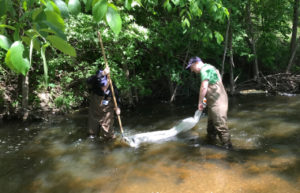HRWC is Getting the word out about microplastics in the Huron River and Great Lakes
Check out our new videos designed to raise awareness of local microplastic pollution: what it is, top sources of the pollution, and what we can all do to reduce microplastics in our water. Below you’ll also find a write up about the issue by HRWC’s Watershed Ecologist Paul Steen and a link to our microplastics page for more information and handy take action ideas.
HRWC takes a look at microplastics in our water
By Dr. Paul Steen, HRWC Watershed Ecologist, published in the City of Ann Arbor, Quality Water Matters newsletter
Researchers estimate that 6.3 billion metric tons of plastic waste have been produced since the 1940s, and 79 percent of that is now in landfills or the natural environment. Plastic pollution is not a new problem. What is becoming more and more well known in recent scientific research is the amount of plastic in our oceans, lakes, rivers and streams, and aquatic animals. In particular, microplastics are a growing area of concern in aquatic systems.
What are they are where do they come from?
Microplastics are tiny pieces of plastic (less than 5 millimeters) mostly invisible to the naked eye. They are the miniscule plastic fragments that are shed from synthetic fibers, fall off decomposing plastic bottles and bags, and are intentionally manufactured into some toothpastes and lotions. In 2016, the USGS released a study that reported the Huron River had the highest level of microplastics when compared to 28 other large Great Lake tributaries. Based on this study, over 70% of the microplastics in rivers flowing to the Great Lakes come off synthetic clothes and textiles. The culprit is our fleece and synthetic clothing and athletic gear. Around the globe humans have been ingesting microplastics. Very little is known about the impacts they have on human health. We ingest them through our food, water, beer, even breathing in dust. A recent study showed that we each take in about 5 grams of plastic a week, or basically the equivalent of a credit card. More research is needed about how plastics impact our health, what contaminants they pick up and introduce to our systems, and which plastics have stronger impacts over others so we can strategically address the issue.
What’s next?
What can we all do today? Wash your fleece less. The fibers slough off and go through the wastewater treat facilities and to the river. Get a washing machine filter that can pull out the fibers. Buy fewer synthetic textiles like polyester, spandex, nylon, and acrylic. Wear natural and synthetic blends, which are better than 100% synthetic. Best yet, go all natural with 100% cotton, wool, linen, silk, or bamboo. Encourage fabric manufacturers to research alternatives. Check out other take action options here.

This summer HRWC is sampling river water all over the watershed to determine where microplastics hotspots are. With that information, we will be better equipped to look for sources and work with governments in reducing the total amount in the Huron River.
For more information about microplastics:
Microplastics information page
HRWC’s “Swimming in Plastic”, Huron River Report article



